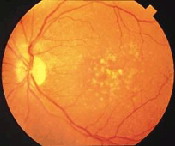
Since November 2010, I have been following Advanced Cell Technology’s (ACT) quest to implement successful clinical trials for macular eye disease, using human embryonic stem cells. ACT’s U.S. and European Phase I/II clinical trials each involve a total of 12 patients, in groups of three (also called cohorts). The first group/cohort received a dosage of 50,000 cells, the second will receive 100,000 cells, the third will receive 150,000 cells and the final group/cohort will be dosed with 200,000 cells.
The Most Recent Clinical Trial
On April 15, 2013, ACT announced treatment of the first patient in cohort 2a, consisting of patients with better vision, in its U.S. clinical trial for Stargardt disease. The surgery was performed at Wills Eye Institute in Philadelphia by Joseph Maguire, M.D. and overseen by Carl D. Regillo, MD, FACS, director of the Wills Eye Clinical Retina Research Unit and professor of ophthalmology at Thomas Jefferson University. The patient was injected with 100,000 human embryonic stem cell-derived retinal pigment epithelial (RPE) cells.
Here is more information from an Advanced Cell Technology press release:
As the company announced on Jan. 22, patients with a visual acuity of 20/100 are eligible for enrollment in cohort 2a in the two U.S. clinical trials, for [Stargardt disease] and dry age-related macular degeneration.
By treating patients earlier in the course of the disease, the Company believes that the amended patient protocol may have a more significant impact on photoreceptor rescue and visual function. In previous protocols, only [Stargardt disease] patients with a visual acuity no better than hand movement in the treated eyes and dry age-related macular degeneration patients with a visual acuity of 20/400 were eligible.
Prior Clinical Trial Highlights
In November 2012, ACT secured approval to proceed with the increased 100,000-cell dosage to the second patient groups/cohorts of both the Stargardt disease and dry age-related macular degeneration (AMD) clinical trials. ACT also announced that Scotland’s NHS Lothian will be an additional site for their European clinical trial for Stargardt disease.
On November 28, 2012, ACT announced the treatment of the fifth and sixth patients in the company’s Phase I/II clinical trial for dry AMD, completing the second patient group/cohort. The fifth patient was treated at Massachusetts Eye and Ear Infirmary, a Harvard Medical School affiliate, by a surgical team led by Dean Eliott, M.D., a retina surgeon and associate director of the Retina Service. Also, the sixth patient in ACT’s clinical trial for Stargardt disease was treated, completing the second Stargardt group/cohort.
Moorfields Eye Hospital
On July 27, 2012, ACT announced the treatment of the third patient in its European Phase I/II clinical trials for Stargardt disease, using retinal pigment epithelial (RPE) cells derived from human embryonic stem cells. The most recent surgery was performed at Moorfields Eye Hospital in London, England by a surgical team led by Professor James Bainbridge, consultant surgeon at Moorfields and Chair of Retinal Studies at University College London. The first patient was treated on January 20, 2012, and the second on June 29, 2012.
Wills Eye Institute
On February 15, 2012, ACT announced that Wills Eye Institute received institutional review board (IRB) approval as a site for ACT’s Phase I/II clinical trial for Stargardt disease. In January, ACT also announced that the IRB at Wills had approved the participation of the institution as a site for ACT’s clinical trial for dry AMD.
On July 11, 2012, ACT announced the treatment of the fourth patient (the first in the second patient cohort) in its U.S. clinical trial for Stargardt disease. The surgery was performed by a surgical team led by Carl D. Regillo, MD, FACS. The Wills patient was injected with 100,000 cells, compared with the 50,000-cell dose used in the previous trial.
On August 12, 2012, Dr. Regillo treated the fourth patient (the first in the second patient cohort, also receiving a 100,000-cell dosage) in the Phase I/II clinical trial for dry AMD.
Jules Stein Eye Institute
On July 12, 2011, ACT announced the treatment of the first two patients in its Phase I/II clinical trials for Stargardt disease and dry AMD. The surgery was performed by Steven Schwartz, M.D., Ahmanson Professor of Ophthalmology at the David Geffen School of Medicine and retina division chief at the Jules Stein Eye Institute, both at UCLA. On January 24, 2012, Dr. Schwartz treated the second patient in the Phase I/II trial for Stargardt disease.
Additional Background Information
To better understand this latest development, here is background information from my prior blog posts about ACT’s initial stem cell clinical trial for Stargardt disease and its subsequent clinical trial for dry age-related macular degeneration:
On November 22, 2010, the U.S. Food and Drug Administration (FDA) lifted a prior clinical hold on stem cell research to clear Advanced Cell Technology’s Investigational New Drug (IND) application and initiate a Phase I/II multicenter study, using retinal cells derived from human embryonic stem cells to treat patients with Stargardt disease.
ACT’s product is a human embryonic stem cell trained to become a retinal cell. ACT first requested approval from the FDA to conduct the clinical trial approximately one year ago.
On January 3, 2011, ACT announced that they had received FDA clearance for yet another new clinical trial, this time using embryonic stem cells to treat dry AMD.
More Clinical Trial Information
Further information about patient eligibility for ACT’s Stargardt disease study and concurrent studies in the U.S. and Europe for dry AMD and Stargardt disease are available at ClinicalTrials.gov, with the following Identifiers: NCT01345006 (U.S. Stargardt disease), NCT01344993 (U.S. dry AMD), and NCT01469832 (European Stargardt disease).
VisionAware will continue to track stem cell research and provide updates as they become available.